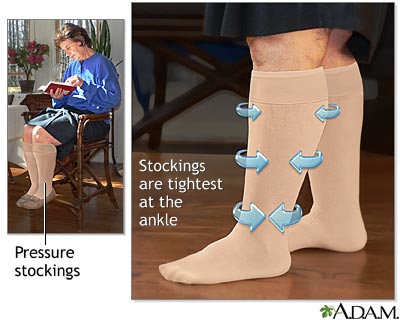Deep vein thrombosis - discharge
You were treated for deep vein thrombosis (DVT). This is a condition in which a blood clot forms in a vein that is not on or near the surface of the body.
Deep vein thrombosis
Deep vein thrombosis (DVT) is a condition that occurs when a blood clot forms in a vein deep inside a part of the body. DVT mainly affects the large...

It mainly affects the large veins in the lower leg and thigh. The clot can block blood flow. If the clot breaks off and moves through the bloodstream, it can get stuck in the blood vessels in the lungs.
Self-care
Wear the pressure stockings if prescribed by your health care provider. They may improve blood flow in your legs and may lower your risk for long-term complications and problems with blood clots.
Pressure stockings
You wear compression stockings to improve blood flow in the veins of your legs. Compression stockings gently squeeze your legs to move blood up your...

- Avoid letting the stockings become very tight or wrinkled.
- If you use lotion on your legs, let it dry before you put the stockings on.
- Put powder on your legs to make it easier to put on the stockings.
- Wash the stockings each day with mild soap and water. Rinse and let them air dry.
- Be sure you have a second pair of stockings to wear while the other pair is being washed.
- If your stockings feel too tight, tell your provider. Do not just stop wearing them.
Your provider may give you medicine to thin your blood to help keep more clots from forming. The medicines warfarin (Coumadin, Jantoven), rivaroxaban (Xarelto), and apixaban (Eliquis) are examples of blood thinners. If you're prescribed a blood thinner:
- Take the medicine just the way your provider prescribed.
- Know what to do if you miss a dose.
- You may need to get blood tests often to make sure you are taking the right dose.
Ask your provider what exercises and other activities are safe for you to do.
Do not sit or lie down in the same position for long periods.
- Do not sit so that you put steady pressure on the back of your knee.
- Prop up your legs on a stool or chair if your legs swell when you sit.
If swelling is a problem, keep your legs resting above your heart. When sleeping, make the foot of the bed a few inches higher than the head of the bed.
When traveling:
- By car. Stop often, and get out and walk around for a few minutes.
- On a plane, bus, or train. Get up and walk around often.
- While sitting in a car, bus, plane, or train. Wiggle your toes, tighten and relax your calf muscles, and shift your position often.
Do not smoke. If you do, ask your provider for help quitting.
Help quitting
There are many ways to quit smoking. There are also resources to help you. Family members, friends, and co-workers may be supportive. But to be su...

Drink at least 6 to 8 cups (1.5 to 2 liters) of liquid a day, if your provider says it is OK.
Use less salt.
- Do not add extra salt to your food.
- Do not eat canned foods and other processed foods that have a lot of salt.
- Read food labels to check the amount of salt (sodium) in foods. Ask your provider how much sodium is OK for you to eat each day.
When to Call the Doctor
Contact your provider if:
- Your skin looks pale, blue, or feels cold to touch
- You have more swelling in either or both of your legs
- You have fever or chills
- You are short of breath (it is hard to breathe)
- You have chest pain, especially if it gets worse upon taking a deep breath in
- You cough up blood
Reviewed By
Todd Gersten, MD, Hematology/Oncology, Florida Cancer Specialists & Research Institute, Wellington, FL. Review provided by VeriMed Healthcare Network. Also reviewed by David C. Dugdale, MD, Medical Director, Brenda Conaway, Editorial Director, and the A.D.A.M. Editorial team.
Centers for Disease Control and Prevention website. Venous thromboembolism (blood clots). www.cdc.gov/blood-clots/about/?CDC_AAref_Val=https://www.cdc.gov/ncbddd/dvt/facts.html. Updated May 15, 2024. Accessed May 28, 2024.
Kabrhel C. Pulmonary embolism and deep vein thrombosis. In: Walls RM, ed. Rosen's Emergency Medicine: Concepts and Clinical Practice. 10th ed. Philadelphia, PA: Elsevier; 2023:chap 74.
Stevens SM, Woller SC, Kreuziger LB, et al. Antithrombotic therapy for VTE disease: Second update of the CHEST guideline and expert panel report. Chest. 2021;160(6):e545-e608. PMID: 34352278 pubmed.ncbi.nlm.nih.gov/34352278/.

 All rights reserved.
All rights reserved.